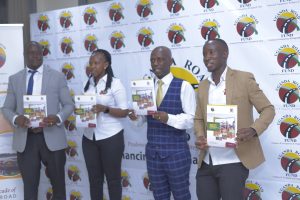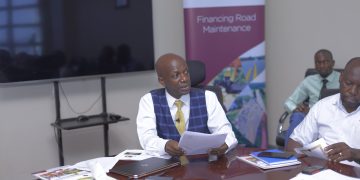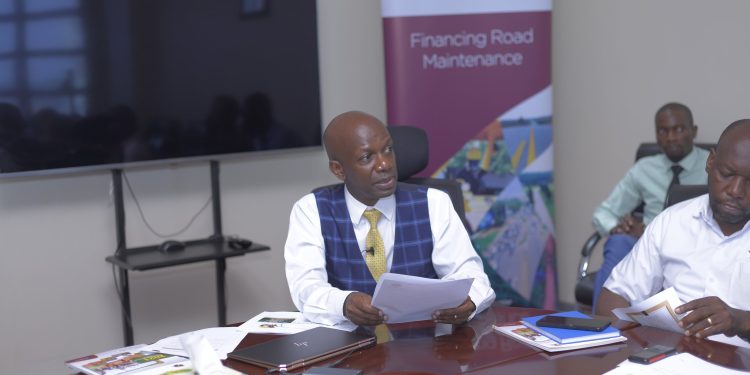Findings from the 2021 Road User Satisfaction Survey (RUSS) have shown that there was a decline in road user satisfaction in 2021 with road users rating their experience on Ugandan roads at 2.39 points out of 4 compared to 2.51 points in 2019.
Releasing the survey on Tuesday, DR. Eng. Andrew G Naimanye, the Executive Director of Uganda Road Fund (URF), said majority of the road users on all categories of roads were dissatisfied with their experience on Ugandan roads, saying only 46.8% of the road users were satisfied.
Naimanye noted that the percentage of respondents who were satisfied with their experience on Uganda’s road network declined by 10 percentage points between 2019 and 2021.
According to him, most of the road users attributed the decline in satisfaction to potholes at (24%), dust (17%), narrow road widths (15%), poor drainage (12%) and inadequate road maintenance (11%).
He, however, revealed that road users who reported an improvement in their road user experience attributed the improvement mostly to better road maintenance and rehabilitation works.
The reasons included; roads that were widened (5%), improved road signage and road markings (17%), and reduced congestion and quicker journey times each of which accounted for 5% of the reasons for improved road user experience.
By specific road network; of the road users who felt that national roads had improved, most (27%) attributed the improvement to road maintenance followed by road reconstruction (26%) and better road signage and marking (17%).
Users of District, Urban and Community Access Roads (DUCAR), shared the same sentiments except that road maintenance was more pronounced than on national roads while road markings were less prominent on DUCAR.
Dr Naimanye noted that respondents faulted road agencies for less than satisfactory performance in the construction of roads with short lifespans and unsuitable road designs.
“At 2.76 out of 4.0 points, Uganda National Roads Authority (UNRA) had the highest overall service provision rating in 2021 followed by Kampala Capital City Authority (KCCA) (2.48 points), as was the case in the last survey while Local Governments, at 2.41 points, had the lowest overall service provision rating in 2021,” he said.

UNRA was the best-rated agency in the provision of each of the other road services assessed except for road rehabilitation where it had nearly the same score as KCCA.
The survey also revealed that perceptions about the safety of the public roads network in 2021 showed a slight decline in road safety with road users rating the safety of Uganda’s roads at 2.50 points out of 4 points compared to 2.58 points in 2019.
The proportion of road users who felt safe on Uganda’s roads dropped from 58% in 2019 to 51% in 2021.
National roads (at 2.52 points) had the highest safety rating of the road networks with DUCAR and KCCA roads scoring 2.35 points each.
Narrow road width was the most common reason why road users felt unsafe on Uganda’s roads accounting for 23% of the reasons for feeling unsafe on Uganda’s road network in 2021 followed by the presence of potholes (18%), reckless driving by motorists (10%) and excessive dust (10%).
The survey also established gaps in driver training and testing. Only about 46% of the drivers interviewed had undergone training by a licensed driving school or certified driving instructor.
The rest of the drivers were either self-taught (24%) or taught by a colleague, friend, or relative who wasn’t a licensed instructor (30%).
The situation for driver training was much worse among motorcyclists compared to motorists since only 9% of the motorcyclists reported to have undergone training by a qualified instructor.
The 2021 Road User Satisfaction Survey Report 4 Perceptions among road users about the Central Government’s commitment to improving the road network and reducing road accidents were positive with over 90% of the respondents agreeing with the statement that “The Government is committed to improving the road network” and 79% of the respondents agreeing that “The Government is committed to reducing accidents on the roads”.
Dr Naimanye said that this explained the willingness of road users to pay a road toll or levy to improve Uganda’s road network which was relatively encouraging at 68% of all respondents interviewed in 2021 although it was lower compared to 70% in 2019.
He said the willingness to pay road tolls was highest among motorists compared to motorcyclists.
Over three-quarters of the respondents felt that they are not adequately consulted about planned projects nor provided with relevant information about ongoing road projects.
These were more pronounced for KCCA and Local Governments compared to UNRA.
The top five areas that respondents felt needed to be prioritized by road agencies in 2021 in order to improve road users’ experiences on Uganda’s roads included; widening of roads, better road maintenance, upgrading gravel/earth roads to tarmac, improving road safety and construction of roads with a longer lifespan.
Also, priorities for pedestrians as a vulnerable road user group included; construction of more designated pathways for pedestrians, widening of roads, pothole repair, better road designs, and dust control respectively.
The RUSS, introduced in 2012 by the URF is a mechanism for seeking public perceptions about service provision in the road’s subsector.
The RUSS provides feedback to the road sector to spark off required improvements in an effort to establish road users’ satisfaction with the condition of Uganda’s road network and related services provided by road agencies in FY2020/21.
Uganda Road Fund conducted the 2021 Road User Satisfaction Survey among 2,797 respondents drawn from seven road user groups, namely; pedestrians, passengers, cyclists, motorcyclists, motorcar drivers, taxi/ bus drivers, and truck drivers on both paved and unpaved roads spread across the different regions of the country.
The Survey comes against the backdrop of numerous road accidents which claimed more than 30 people in a month.








